

Woman, 1966
Alice Neel
The Indian woman who sat for a notable American portrait in the ’60s and forgot about it – until now
In Donald Trump’s America, a painting by Alice Neel acknowledges the history of Indian immigrants.
In a 1966 portrait currently on display at an art gallery in Manhattan, a dimpled young Indian woman sits on a deck chair, looking amused. Her mauve bandhani sari, its pallu wrapped snugly around her hips, accentuates her figure. The white of her petticoat is visible under layers of chiffon (too diaphanous to be polyester, not crumpled or starched enough to be cotton). Her blouse, also white, is sleeveless. Bollywood heroines started wearing sleeveless blouses in the 1960s, so she must have been quite fashionable.
She looks a little like Sharmila Tagore.
Her thick braid falls down her right shoulder and dangles below the seat. She poses with the long fingers of her right hand resting on her cheek, her chin a few inches above her palm. Her large brown eyes are lined with kohl, her gaze is confident. She stands out in Alice Neel, Uptown, an exhibition of selected portraits by the American artist Alice Neel at the David Zwirner gallery in Chelsea.
...She also remains conspicuous by her absence in the art historian Pamela Allara’s Pictures of People: Alice Neel’s American Portrait Gallery, which chronicles Neel’s life and work. Allara writes that Neel “revived and redirected the dying genre of ameliorative portraiture by merging objectivity with subjectivity, realism with expressionism”. Neel described herself as a “collector of souls,” Allara writes, adding that she was categorised as “a sort of artist-sociologist”.
Neel painted the mysterious woman a year after the 1965 Immigration and Nationality Act profoundly changed the American immigration policy, removing longstanding quotas on newcomers from India (among other places). Indians called it the “brain drain”, as the highly educated – particularly doctors – left for the American dream.
Was the woman in the portrait a young doctor then?
She wears gold jewellery – balis, a bangle, and a ring on her middle finger. A red bindi dots her forehead. A pinkish shadow on her hairline seems like the remnant of sindoor. She evokes a picture of Ashima Ganguli, the Bengali housewife in Jhumpa Lahiri’s The Namesake, set in the American North East during the same time period.
Neel had moved to a “more middle-class neighborhood” near Columbia University when she painted this young woman. Was she then a student at Columbia? Or a professor?
...The answer to the mystery finally arrived in an email from a research archivist at the David Zwirner gallery: “The sitter in the portrait is known to be the daughter of the Indian social-realist novelist Bhabani Bhattacharya (1906-1988), who had been invited to New York at the time by his American editor Millen Brand of Crown Publishers. At the time of this sitting, Bhattacharya’s daughter was enrolled as a student at Columbia University.”
...[Her name is] Ujjaini Khanderia of Ann Arbor, Michigan...
[Article continues at https://scroll.in/magazine/835401/the-indian-woman-who-sat-for-a-notable-american-portrait-in-the-60s-and-forgot-about-it-until-now]
46 x 31 in
Uploaded on Mar 19, 2018 by Suzan Hamer
Alice Neel
artistArthur
Wait what?













